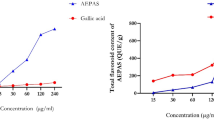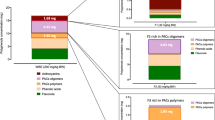Abstract
Aim:
Biotransformation of blueberry juice by the Serratia vaccinii bacterium gave rise to adenosine monophosphate-activated protein kinase (AMPK) phosphorylation and glucose uptake in muscle cells and adipocytes, but inhibited adipogenesis. This study investigated the antiobesity and antidiabetic potential of biotransformed blueberry juice (BJ) in KKAy mice, rodent model of leptin resistance.
Methods:
BJ was incorporated in drinking water of KKAy mice. Parameters of body weight, food intake, plasma glucose, insulin, leptin, and adiponectin were measured. Before and after therapy, animals were subjected to an oral glucose tolerance test. At the end of treatment, liver, muscle, kidney, epididymal fat pad, abdominal fat pad, and dorsal fat pad were collected and weighed.
Results:
Incorporating BJ in drinking water protected young KKAy mice from hyperphagia and significantly reduced their weight gain. Moreover, BJ protected young KKAy mice against the development of glucose intolerance and diabetes mellitus. Chronic BJ administration in obese and diabetic KKAy mice reduced food intake and body weight. This effect could not fully explain the associated antidiabetic effect because BJ-treated mice still showed lower blood glucose level when compared with pair-fed controls. The adipokines pathway also seems to be involved because BJ significantly increased adiponectin levels in obese mice.
Conclusions:
This study shows that BJ decreases hyperglycemia in diabetic mice, at least in part by reversing adiponectin levels. BJ also protects young pre-diabetic mice from developing obesity and diabetes. Thus, BJ may represent a novel complementary therapy and a source of novel therapeutic agents against diabetes mellitus.
This is a preview of subscription content, access via your institution
Access options
Subscribe to this journal
Receive 12 print issues and online access
$259.00 per year
only $21.58 per issue
Buy this article
- Purchase on Springer Link
- Instant access to full article PDF
Prices may be subject to local taxes which are calculated during checkout








Similar content being viewed by others
References
James PT . Obesity: the worldwide epidemic. Clin Dermatol 2004; 22: 276–280.
de Ferranti S, Mozaffarian D . The perfect storm: obesity, adipocyte dysfunction, and metabolic consequences. Clin Chem 2008; 54: 945–955.
Kershaw EE, Flier JS . Adipose tissue as an endocrine organ. J Clin Endocrinol Metab 2004; 89: 2548–2556.
Mojiminiyi OA, Abdella NA, Al Arouj M, Ben Nakhi A . Adiponectin, insulin resistance and clinical expression of the metabolic syndrome in patients with Type 2 diabetes. Int J Obes (Lond) 2007; 31: 213–220.
Hivert MF, Sullivan LM, Fox CS, Nathan DM, D'Agostino Sr RB, Wilson PW et al. Associations of adiponectin, resistin, and tumor necrosis factor-alpha with insulin resistance. J Clin Endocrinol Metab 2008; 93: 3165–3172.
Yang B, Brown KK, Chen L, Carrick KM, Clifton LG, McNulty JA et al. Serum adiponectin as a biomarker for in vivo PPARgamma activation and PPARgamma agonist-induced efficacy on insulin sensitization/lipid lowering in rats. BMC Pharmacol 2004; 4: 23.
Katsuda Y, Asano A, Murase Y, Chujo D, Yagi K, Kobayashi J et al. Association of genetic variation of the adiponectin gene with body fat distribution and carotid atherosclerosis in Japanese obese subjects. J Atheroscler Thromb 2007; 14: 19–26.
Van Gaal LF, Scheen AJ, Rissanen AM, Rossner S, Hanotin C, Ziegler O . Long-term effect of CB1 blockade with rimonabant on cardiometabolic risk factors: two year results from the RIO-Europe Study. Eur Heart J 2008; 29: 1761–1771.
Scheen AJ, Van Gaal LF . Rimonabant as an adjunct therapy in overweight/obese patients with type 2 diabetes. Eur Heart J 2007; 28: 1401–1402; author reply 1402.
Guerre-Millo M . Adiponectin: an update. Diabetes Metab 2008; 34: 12–18.
Chambers BK, Camire ME . Can cranberry supplementation benefit adults with type 2 diabetes? Diabetes Care 2003; 26: 2695–2696.
Jellin J, Gregory P, Batz F, Hitchens K . Natural Medicines Comprehensive Database. 3rd edn Pharmacist'sLetter/Prescriber'sLetter pp 2239 Therapeutic Research Faculty: Stockon, CA, 2005.
Haddad PS, Depot M, Settaf A, Chabli A, Cherrah Y . Comparative study on the medicinal plants. Most recommended by traditional practitioners in Morocco and Canada. J Herbs Spices Med Plants 2003; 10: 25–45.
Martineau LC, Couture A, Spoor D, Benhaddou-Andaloussi A, Harris C, Meddah B et al. Anti-diabetic properties of the Canadian lowbush blueberry Vaccinium angustifolium Ait. Phytomedicine 2006; 13: 612–623.
Kahkonen MP, Hopia AI, Heinonen M . Berry phenolics and their antioxidant activity. J Agric Food Chem 2001; 49: 4076–4082.
Yi W, Akoh C, Fischer J, Krewer G . Effects of phenolic compounds in blueberries and muscadine grapes on HepG2 cell viability and apoptosis. Food Res Int 2006; 39: 628–638.
Matchett MD, MacKinnon SL, Sweeney MI, Gottschall-Pass KT, Hurta RA . Inhibition of matrix metalloproteinase activity in DU145 human prostate cancer cells by flavonoids from lowbush blueberry (Vaccinium angustifolium): possible roles for protein kinase C and mitogen-activated protein-kinase-mediated events. J Nutr Biochem 2006; 17: 117–125.
Martin L, Matar C . Increase of antioxidant capacity of the lowbush blueberry (Vaccinium angustifolium) during fermentation by a novel bacterium from the fruit microflora. J Sci Food Agri 2005; 85: 1477–1484.
Vuong T, Martineau LC, Ramassamy C, Matar C, Haddad PS . Fermented Canadian lowbush blueberry juice stimulates glucose uptake and AMP-activated protein kinase in insulin-sensitive cultured muscle cells and adipocytes. Can J Physiol Pharmacol 2007; 85: 956–965.
Srinivasan K, Ramarao P . Animal models in type 2 diabetes research: an overview. Indian J Med Res 2007; 125: 451–472.
Calkin AC, Allen TJ . Diabetes mellitus-associated atherosclerosis: mechanisms involved and potential for pharmacological invention. Am J Cardiovasc Drugs 2006; 6: 15–40.
Nindo CI, Tang J, Powers JR, Singh P . Viscosity of blueberry and raspberry juices for processing applications. J Food Eng 2005; 69: 343–350.
Meglasson MD, Wilson JM, Yu JH, Robinson DD, Wyse BM, de Souza CJ . Antihyperglycemic action of guanidinoalkanoic acids: 3-guanidinopropionic acid ameliorates hyperglycemia in diabetic KKAy and C57BL6Job/ob mice and increases glucose disappearance in rhesus monkeys. J Pharmacol Exp Ther 1993; 266: 1454–1462.
Kotronen A, Vehkavaara S, Seppala-Lindroos A, Bergholm R, Yki-Jarvinen H . Effect of liver fat on insulin clearance. Am J Physiol Endocrinol Metab 2007; 293: E1709–E1715.
Laviola L, Perrini S, Cignarelli A, Natalicchio A, Leonardini A, De Stefano F et al. Insulin signaling in human visceral and subcutaneous adipose tissue in vivo. Diabetes 2006; 55: 952–961.
Lazar MA . How obesity causes diabetes: not a tall tale. Science 2005; 307: 373–375.
Yamauchi T, Kamon J, Waki H, Terauchi Y, Kubota N, Hara K et al. The fat-derived hormone adiponectin reverses insulin resistance associated with both lipoatrophy and obesity. Nat Med 2001; 7: 941–946.
Combs TP, Berg AH, Obici S, Scherer PE, Rossetti L . Endogenous glucose production is inhibited by the adipose-derived protein Acrp30. J Clin Invest 2001; 108: 1875–1881.
Furukawa S, Fujita T, Shimabukuro M, Iwaki M, Yamada Y, Nakajima Y et al. Increased oxidative stress in obesity and its impact on metabolic syndrome. J Clin Invest 2004; 114: 1752–1761.
Bruun JM, Lihn AS, Verdich C, Pedersen SB, Toubro S, Astrup A et al. Regulation of adiponectin by adipose tissue-derived cytokines: in vivo and in vitro investigations in humans. Am J Physiol Endocrinol Metab 2003; 285: E527–E533.
Vuong T, Martin L, Matar C . Antioxidant activity of fermented berry juices and their effects on nitric oxide and tumor necrosis factor-alpha production in macrophage 264.7 gamma NO(–) cell line. J Food Biochem 2006; 30: 249–268.
Prior RL, Wu X, Gu L, Hager TJ, Hager A, Howard LR . Whole berries versus berry anthocyanins: interactions with dietary fat levels in the C57BL/6J mouse model of obesity. J Agric Food Chem 2008; 56: 647–653.
Acknowledgements
Funding of the study was provided by the Canadian Institutes of Health Research (CIHR), Atlantic Innovation Fund, Atlantic Canada Opportunities Agency (ACOA) and Institute of Nutraceuticals and Functional Foods (INAF) of Laval University, a Strategic Research Group of the Quebec Fonds de recherche sur la nature et les technologies (FQRNT).
Author information
Authors and Affiliations
Corresponding author
Rights and permissions
About this article
Cite this article
Vuong, T., Benhaddou-Andaloussi, A., Brault, A. et al. Antiobesity and antidiabetic effects of biotransformed blueberry juice in KKAy mice. Int J Obes 33, 1166–1173 (2009). https://doi.org/10.1038/ijo.2009.149
Received:
Revised:
Accepted:
Published:
Issue Date:
DOI: https://doi.org/10.1038/ijo.2009.149
Keywords
This article is cited by
-
Phenolic compounds isolated from fermented blueberry juice decrease hepatocellular glucose output and enhance muscle glucose uptake in cultured murine and human cells
BMC Complementary and Alternative Medicine (2017)
-
Fermented blueberry juice extract and its specific fractions have an anti-adipogenic effect in 3 T3-L1 cells
BMC Complementary and Alternative Medicine (2017)
-
Effects of blueberry supplementation on blood pressure: a systematic review and meta-analysis of randomized clinical trials
Journal of Human Hypertension (2017)
-
Role of a polyphenol-enriched preparation on chemoprevention of mammary carcinoma through cancer stem cells and inflammatory pathways modulation
Journal of Translational Medicine (2016)
-
Supplementing Diet with Blackberry Extract Causes a Catabolic Response with Increments in Insulin Sensitivity in Rats
Plant Foods for Human Nutrition (2015)



